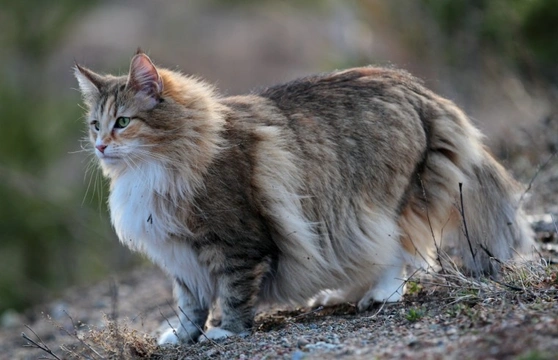
10 things you need to know about the Norwegian forest cat before you buy one
The Norwegian forest cat is an imposing and very handsome cat breed that will certainly be apt to stop you in your tracks and make you look twice if you should happen to see one of them out and about.
This is a breed that has a lot of very unique traits in terms of both looks and temperament that makes the Norwegian forest cat stand out from the crowd and as such, this is a breed that a lot of cat lovers one day aspire to owning.
However, this is not a breed to buy on a whim, and there are a number of things that all prospective Norwegian forest cat owners need to know about the breed and their care and traits before committing to a purchase.
With this in mind, this article will tell you ten things you need to know about the Norwegian forest cat breed to kick start your research and get you going along the right tracks. Read on to learn more.
1. The Norwegian forest cat is very large
The Norwegian forest cat is one of the largest domestic cat breeds of all, and larger cats of the breed can be easily double the size or more of the average cat, causing some people to question whether or not they are truly domestic cats!
Males of the breed can weigh up to around 9kg, with females usually being a touch smaller.
2. They can be quite costly to keep, but not overly expensive to buy
The Norwegian forest cat needs a large bed, cat flap, and other accessories and of course, they also get through a lot of food! Caring for and insuring a Norwegian forest cat can be expensive, but they are actually one of the cheaper pedigree cat breeds to buy, with average sale prices for pedigrees being around the £557 mark, and for non pedigrees, £353 according to our Pets4Homes advertising statistics.
3. They have long, thick coats
The Norwegian forest cat’s coat is long and thick and adds to their bulk, making cats of the breed look even larger than they really are! They have a long, glossy topcoat and thick, plush down undercoat, and this requires a reasonable amount of brushing and grooming in order to keep it in good condition.
4. Norwegian forest cats tend to be active and outdoorsy
The Norwegian forest cat breed as a whole tends to be a fairly active one, and whilst they do sleep a lot (as all cats do), they tend to spend a lot of time outdoors and often have quite a large territory.
They are also adept climbers and can often be found up trees and in high places, and are one of the more adventurous cat breeds to choose.
5. They often have a strong prey drive
Norwegian forest cats also tend to have a strong prey drive, and they are often keen and skilful hunters.
They may bring you back dead rodents as gifts and make much fanfare about this, or they might eat a significant amount of what they catch and supplement their own diets, which means they should always be wormed and flea treated regularly.
6. The breed is built for cold weather and may find summer challenging
The Norwegian forest cat’s coat is designed to insulate and protect them from the very harsh winters of their native Norway, but it does mean that they will tend to be a little overly warm in the summer. Always provide access to cool fresh water and plenty of shade for your cat, but don’t worry unduly – whilst the Norwegian forest evolved in a cold climate, cats as a species are desert animals, and so quite adept at staying cool in hot weather.
7. They are one of the more intelligent cat breeds
The Norwegian forest cat is generally considered to be one of the more intelligent and streetwise of cat breeds, although this can of course be variable and the level of smarts that any given cat displays can be quite variable too!
8. The breed tends to be relatively hardy and long lived
Norwegian forest cats as a whole don’t tend to suffer from a wide range of minor ills, and tend to be fairly hardy. Their average lifespans are longer than that of most other pedigree breeds too, being around 14-16 years.
9. There are some hereditary health issues within the breed
Whilst cats of the breed tend to live to old age in good health, there are some hereditary breed-specific health issues found within the breed too, including heart and kidney disease.
However, the health of individual breed lines can be highly variable, and there are no guarantees of lifelong good health for any cat, however careful you are about picking a breeder.
10. They don’t tend to thrive as indoor only cats
The Norwegian forest cat tends to be outdoorsy, active an fairly lively, and so they are not generally considered to be a good choice of cat to be kept indoors only.
Whilst this may be viable if a kitten is kept indoors only from the get-go, if you live in a small apartment or can’t provide safe access to the outdoors, this might not be a good choice of breed to pick.



